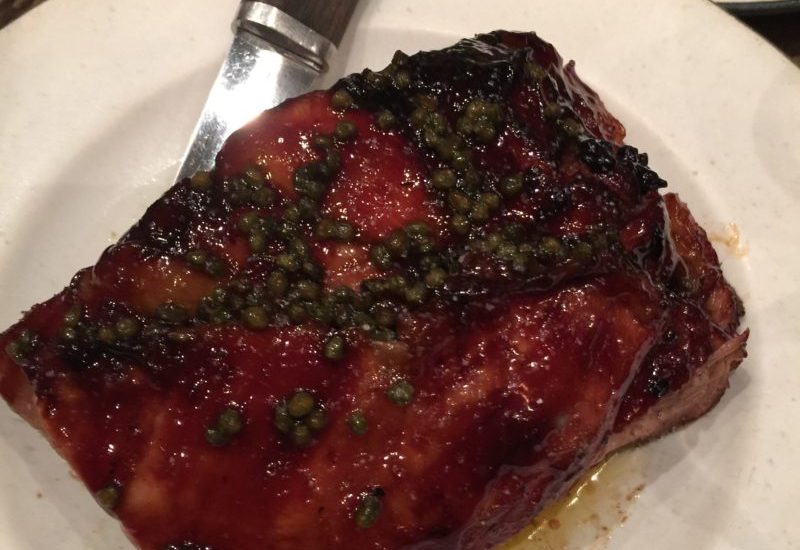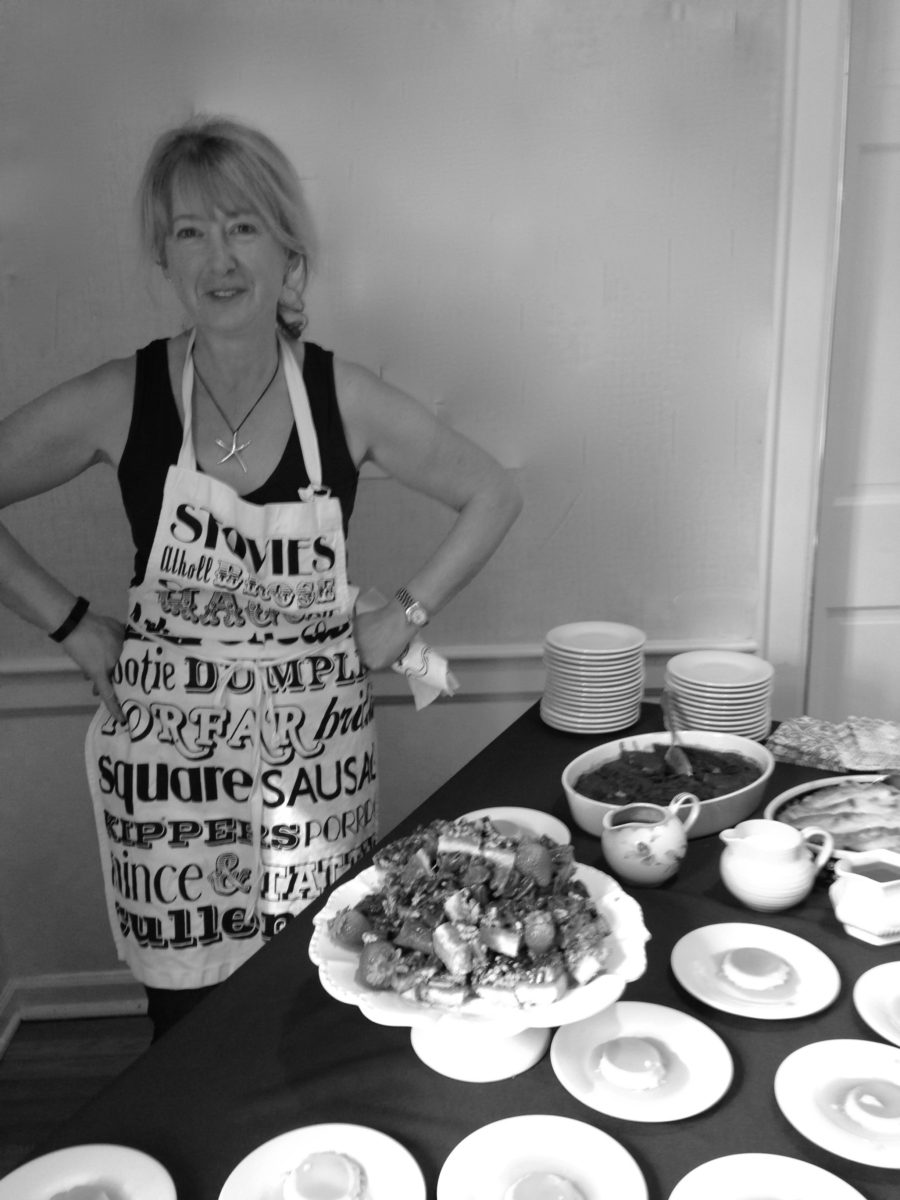A few weeks ago I helped out at the Darien Men’s Association Soiree at Weed Beach. The full menu appears under the menu tab on my website. The food was fabulous, Roberto and two other members of staff from Tokenize club helped out at the grill, I did most of the food but in my mind the star of the show was the Korean pulled pork cooked by the, then President, Bob Smith. He has very kindly shared his recipe which came originally from the NYT. He has also kindly shared the flank steak recipe from the evening.
The Bo Ssam Miracle by Sam Sifton
This weekend’s dinner is a slow-roasted shoulder of pig, a meal that can be picked apart by a table of friends armed only with chopsticks and lettuce. A tight and salty caramel crust sits on top of the moist, fragrant collapse of meat, and juices run thick to pool beneath it, a kind of syrup, delicious in its intensity. It is pork as pommes soufflé.
The dish is known in Korea as bo ssam — pork wrapped like a package in fresh greens, with rice and kimchi. David Chang, the chef and an owner of a small restaurant empire in New York and abroad, offers an exemplary version at his Momofuku Ssam Bar in Manhattan’s East Village for $200, where it serves 6 to 10 people and regularly blows minds. That you can achieve almost exactly the same result at home for a fraction of the cost is both a testament to Chang’s magnanimity (he published a recipe for the dish in his recent “Momofuku” cookbook) and also an example of how important it is for chefs to be able to write good recipes.
The best restaurant kitchens are filled with exceptional cooks, or are meant to be. This is particularly the case in the kitchens run by Chang, whose restless, inventive cooking requires a great deal of skill and training. You cannot stuff mushroom caps in a sports bar and then expect to get a job working for him straight out of culinary school. (You can try!) But hacks will still sometimes get in the door, just as they do in every game: craftsmen rather than artists, regular joes, people exactly like most of us.
For them, perhaps (for us, for sure!), recipes like Chang’s bo ssam are a godsend. They make any cook appear to be better than he or she really is, elevating average kitchen skills into something that approaches alchemy. Tell no one how easy this all turns out to be, though. Simply cook the food and serve it and watch as those at your table devour the meat in a kind of trance.
The drill is simple. Buy a pork shoulder — it is generally labeled “Boston butt” in supermarket meat racks. Rinse and dry it with paper towels and cover it in a large bowl with salt and sugar, a dry brine that will begin to cure the meat. The next day, put the shoulder in a low oven for six hours, until the meat surrenders and becomes a kind of heap. Let it rest. Turn the oven on high. Slather on brown sugar and salt, and blast it into lacquer. Rest it again, then serve. (The skin at this point will have fused into a kind of caramel bark; you may need to use a pair of tongs to get at the meat.)
Meanwhile, make condiments. Chang, like most proper New Yorkers, is addicted to the ginger-scallion sauce used to flavor noodles at the Chinatown restaurant Great N.Y. Noodletown. The brightness of the ginger in his version, as well as the zap of the scallions, is an excellent match for the pork.You will need spice too, something with some heat to it, to provide contrast. Kochujang, a sweet Korean hot-pepper paste, is one possibility, as is its cousin ssamjang, a fiery soybean paste. Chang thins out ssamjang with oil and sherry vinegar to achieve a marvelous result. Having all three sauces on the table would not be a waste.
From-scratch kimchi is a tall order for weekend warriors (it takes weeks to achieve the proper taste and fermentation). But commercial varieties are available in some supermarkets and online. In a pinch you can buy new pickles and amplify them with red pepper. Rigorous testing confirms their deliciousness in a homemade bo ssam.
There should be rice on the table and clean, cold bibb lettuce in which to wrap everything up. Chang suggests raw oysters as well. “I like the textural contrast,” he says, “as well as the temperature contrast.” But these are not strictly necessary for the miracle to occur.
What is necessary: close attention to the final disposition of the pork itself, when you return it to the oven to build its crust. “Once that last bit of sugar and salt is on there and the meat is back in a hot oven,” Chang says, “you want to watch it carefully. You’re not looking for a color so much as for the moment when the fat and the skin begins to fluff up a little. It’s not so much about the sugar caramelizing as it is about the fat starting to bubble.” When that happens — Chang calls it the soufflé effect — you are ready to go. The meat should look roughly like a deflated and yet strangely attractive football. Let it rest a little while longer (take some of the sugar-thickened fat and whisk it into your thinned-out ssamjang for some extra oomph) while you gather together a quorum to eat.
Now take a piece of lettuce to show others the way. Place into it a torn string of meat, a dab of rice, some hot sauce or kimchi or pickles. Fold and bite, fold and bite. Try it with a scissored shard of the candied pigskin. Or with an oyster. Or both. Repeat.
Chang served bo ssam at his new restaurant in Australia recently. “We put a lot of sugar on the meat at the end,” he says, “and served it like a pork petit four.” Most of the diners had eaten a full tasting menu already, so Chang did not think people would really eat the ssam. It was almost abusive, he felt: “People were full, you know, they’d eaten like 10 courses already.” But then he looked out at the dining room. The ssams were being taken apart as if by frenzied animals. “People were just housing them,” Chang said. “They smell it and they look at it and they just go crazy.” See for yourself.
Page Break Momofuku Bo Ssam from NY Times
Adapted from “Momofuku,” by David Chang and Peter Meehan
Pork Butt
| 1 whole bone-in pork butt or picnic ham (8 to 10 pounds)with skin removed1 cup white sugar | 1 cup plus 1 tablespoon kosher salt7 tablespoons brown sugar |
Ginger-Scallion Sauce
| 2½ cups thinly sliced scallions, both green and white parts½ cup peeled, minced fresh ginger¼ cup neutral oil (like grapeseed) | 1½ teaspoons light soy sauce1 scant teaspoon sherry vinegar½ teaspoon kosher salt, or to taste |
Ssam Sauce
| 2 tablespoons fermented bean-and- chili paste (ssamjang, available in many Asian markets, and online)1 tablespoon chili paste (kochujang, available in many Asian markets, and online) | ½ cup sherry vinegar½ cup neutral oil (like grapeseed) |
Accompaniments
| 2 cups plain white rice, cooked3 heads Bibblettuce, leaves separated, washed and dried | 1 dozen or more fresh oysters (optional)Kimchi (available in many Asian markets, and online). |
- Place the pork in a large, shallow bowl. Mix the white sugar and 1 cup of the salt together in another bowl, then rub the mixture all over the meat. Cover it with plastic wrap and place in the refrigerator for at least 6 hours, or overnight.
- When you’re ready to cook, heat oven to 300. Remove pork from refrigerator and discard any juices. Place the pork in a roasting pan and set in the oven and cook for approximately 6 hours, or until it collapses, yielding easily to the tines of a fork. After the first hour, baste hourly with pan juices. When the meat collapses, remove the meat from the oven and allow it to rest for up to an hour.
- Meanwhile, make the ginger-scallion sauce. In a large bowl, combine the scallions with the rest of the ingredients. Mix well and taste, adding salt if needed.
- Make the ssam sauce. In a medium bowl, combine the chili pastes with the vinegar and oil, and mix well.
- Prepare rice, wash lettuce and, if using, shuck the oysters. Put kimchi and sauces into serving bowls.
- When your accompaniments are prepared and you are ready to serve the food, turn oven to 500. In a small bowl, stir together the remaining tablespoon of salt with the brown sugar. Rub this mixture all over the cooked pork. Place in oven for approximately 10 to 15 minutes, or until a dark caramel crust has developed on the meat. Serve hot, with the accompaniments.
Serves 6 to 10
Grilled Flank Steak with Rosemary from Bon Appetit 1995
This steak served at Chamberlain’s Prime Chop House in Dallas, Texas, is flavored with a soy sauce, honey marinade and rosemary.
Total Time: Two and one-half hours
Ingredients:
| ½ cup soy sauce½ cup olive oil4 ½ tablespoons honey6 large garlic cloves, minced | 3 tablespoons chopped fresh rosemary1 ½ tablespoons coarsely ground black pepper1 ½ teaspoons salt2 ¼ pound flank steak |
Preparation:
- Mix all ingredients except steak in 13 x 9 x 2-inch glass baking dish. Add steak and turn to coat. Cover and refrigerate 2 hours, turning occasionally.
- Prepare barbeque (medium-high heat) or preheat broiler. Remove meat from marinade; discard marinade. Grill steak to desired doneness, about 4 minutes per side for medium-rare.
- Transfer steak to work surface. Let stand 5 minutes. Cut across grain into thin strips Arrange on platter and serve.
Reviews: http://www.epicurious.com/recipes/food/reviews/grilled-flank-steak-with-rosemary-731



 That's me in the corner
That's me in the corner



